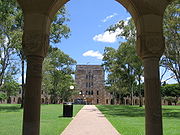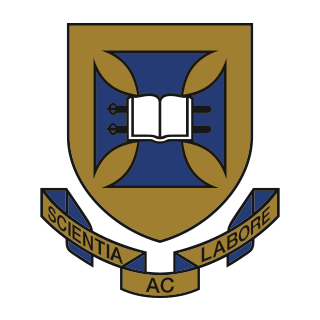
The University of Queensland is a public research university located primarily in Brisbane, the capital city of the Australian state of Queensland. Founded in 1909 by the Queensland parliament, UQ is one of the six sandstone universities, an informal designation of the oldest university in each state. The University of Queensland was ranked second nationally by the Australian Research Council in the latest research assessment and equal second in Australia based on the average of four major global university league tables. The University of Queensland is a founding member of edX, Australia's research-intensive Group of Eight and the global Universitas 21 network.

Bowen Hills is an inner north-eastern suburb in the City of Brisbane, Queensland, Australia. In the 2016 census Bowen Hills had a population of 3,226 people.
Robin Gibson was an Australian architect, from Brisbane, Queensland.

Frederick William Whitehouse was a noted geologist, born in Ipswich, Queensland, Australia.

The culture of Brisbane derives from mainstream Australian culture and incorporates a strong history in the performing arts, music and sport.

John Anthony Hay was an Australian academic. He was Vice-Chancellor of Deakin University and the University of Queensland from 1996 to 2007.

Pinjarra Hills is a suburb in the City of Brisbane, Queensland, Australia. In the 2016 census, Pinjarra Hills had a population of 606 people.

Mary Emelia Mayne, was an Australian philanthropist.

The UQ Law School is the law school of the University of Queensland in Brisbane, Australia. Founded in 1936, the school is the sixth-oldest law school in Australia and the oldest and most prestigious in Queensland. The school is currently the most-cited law school in Australia. Its alumni include six Australian High Court Justices including two Chief Justices of Australia.

The University of Queensland Library, founded in 1910, provides library access to students of the University of Queensland in Brisbane. It developed from a small provincial university library into a major research library. It was first housed in the Old Government House building of George Street from 1911 to 1923. From 1923 to 1948, it was housed in the Art Block of the Central Technical College in George Street, next to the university. In late 1948, the library moved to the new St Lucia campus, residing in the Duhig Building. By 1954, it had already exceeded its capacity.

Pamela Mary Crawford was an Australian artist and stage designer married to the English-born Australian dramatist, James Crawford.
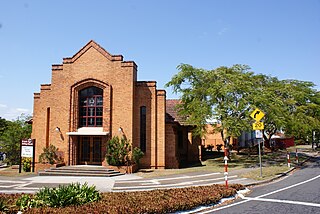
The St Lucia Presbyterian Church is a heritage-listed church at 7 Hawken Drive, St Lucia, City of Brisbane, Queensland, Australia. Built in 1952, it was designed by Ronald Martin Wilson trading as R. Martin Wilson, Architect and Architectural Engineers. The church was originally commissioned for the St Lucia congregation of Presbyterians, subsequently becoming the property of the Uniting Church of Australia. This church was the first substantial commission awarded to R. Martin Wilson after World War II. It is listed on the Brisbane Heritage Register.
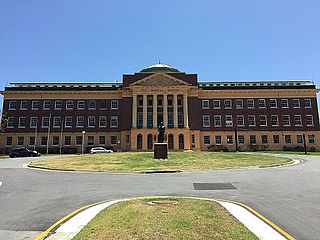
University of Queensland Mayne Medical School is a heritage-listed university building at 288 Herston Road, Herston, City of Brisbane, Queensland, Australia. It was designed by Raymond Clare Nowland and built from 1938 to 1939. It is also known as University of Queensland Medical School. It was added to the Queensland Heritage Register on 24 June 1999.

Great Court is a heritage-listed university colonnade at the University of Queensland, St Lucia, City of Brisbane, Queensland, Australia. It was designed by John (Jack) Hennessy and built from 1937 to 1979. It was added to the Queensland Heritage Register on 8 March 2002.

Jeremiah Joseph Stable (1883–1953) was the first professor of English at the University of Queensland in Brisbane, Queensland, Australia.

Harrison Bryan was an Australian librarian. Bryan was, later, University Librarian at the University of Queensland and University of Sydney and later Director-General of the National Library of Australia.
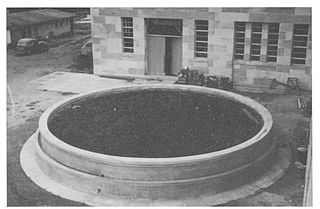
The University of QueenslandSeismology Station was established in 1938 at the University of Queensland, Brisbane, Australia.

The Marks-Hirschfeld Museum of Medical History is a museum at the University of Queensland Mayne Medical School at 288 Herston Road, Herston, City of Brisbane, Queensland, Australia. Operated by volunteers and supported by the University of Queensland Alumni, it has a collection of over 7,000 items of medical memorabilia, medical and surgical instruments. The focus is on the study of medical history in Queensland, but the collection includes items with broader significance to Australia and internationally.
Arthur William Forster Bligh (1905-1998) was an Australian architect, who designed a number of Art Deco buildings in Queensland in the twentieth century.
Professor Nancy Underhill is an art historian, curator, lecturer and author. She is the Founder of the University of Queensland Department of Art History.



















